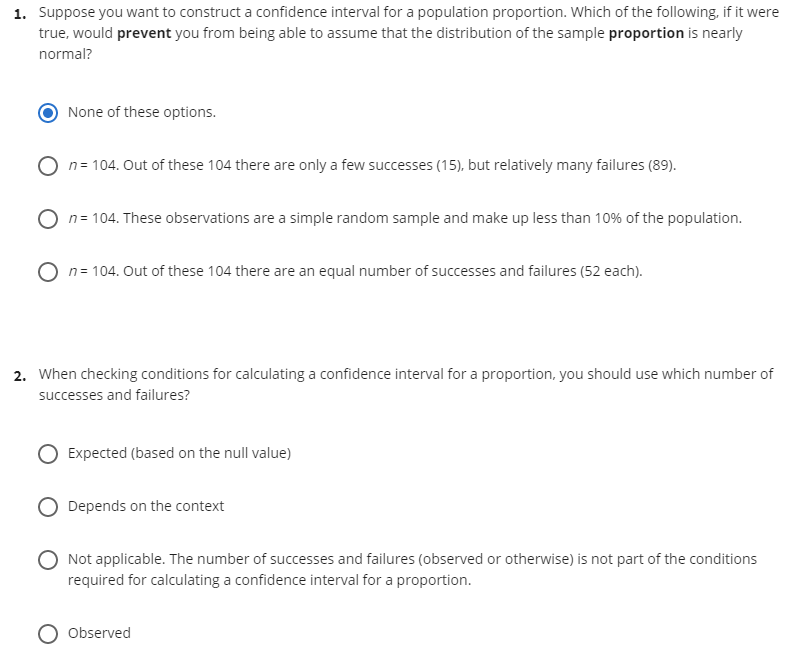1. Suppose you want to construct a confidence interval for a population proportion. Which of the following, if it were true, would prevent you from being able to assume that the distribution of the sample proportion is nearly normal? None of these options. n= 104. Out of these 104 there are only a few successes (15), but relatively many failures (89). O n= 104. These observations are a simple random sample and make up less than 10% of the population. n= 104. Out of these 104 there are an equal number of successes and failures (52 each). 2. When checking conditions for calculating a confidence interval for a proportion, you should use which number of successes and failures? Expected (based on the null value) Depends on the context Not applicable. The number of successes and failures (observed or otherwise) is not part of the conditions required for calculating a confidence interval for a proportion. Observed
1. Suppose you want to construct a confidence interval for a population proportion. Which of the following, if it were true, would prevent you from being able to assume that the distribution of the sample proportion is nearly normal? None of these options. n= 104. Out of these 104 there are only a few successes (15), but relatively many failures (89). O n= 104. These observations are a simple random sample and make up less than 10% of the population. n= 104. Out of these 104 there are an equal number of successes and failures (52 each). 2. When checking conditions for calculating a confidence interval for a proportion, you should use which number of successes and failures? Expected (based on the null value) Depends on the context Not applicable. The number of successes and failures (observed or otherwise) is not part of the conditions required for calculating a confidence interval for a proportion. Observed
MATLAB: An Introduction with Applications
6th Edition
ISBN:9781119256830
Author:Amos Gilat
Publisher:Amos Gilat
Chapter1: Starting With Matlab
Section: Chapter Questions
Problem 1P
Related questions
Question
1-2q

Transcribed Image Text:1. Suppose you want to construct a confidence interval for a population proportion. Which of the following, if it were
true, would prevent you from being able to assume that the distribution of the sample proportion is nearly
normal?
None of these options.
O n= 104. Out of these 104 there are only a few successes (15), but relatively many failures (89).
O n= 104. These observations are a simple random sample and make up less than 10% of the population.
O n= 104. Out of these 104 there are an equal number of successes and failures (52 each).
2. When checking conditions for calculating a confidence interval for a proportion, you should use which number of
successes and failures?
Expected (based on the null value)
Depends on the context
Not applicable. The number of successes and failures (observed or otherwise) is not part of the conditions
required for calculating a confidence interval for a proportion.
O Observed
Expert Solution
This question has been solved!
Explore an expertly crafted, step-by-step solution for a thorough understanding of key concepts.
This is a popular solution!
Trending now
This is a popular solution!
Step by step
Solved in 2 steps with 2 images

Recommended textbooks for you

MATLAB: An Introduction with Applications
Statistics
ISBN:
9781119256830
Author:
Amos Gilat
Publisher:
John Wiley & Sons Inc

Probability and Statistics for Engineering and th…
Statistics
ISBN:
9781305251809
Author:
Jay L. Devore
Publisher:
Cengage Learning

Statistics for The Behavioral Sciences (MindTap C…
Statistics
ISBN:
9781305504912
Author:
Frederick J Gravetter, Larry B. Wallnau
Publisher:
Cengage Learning

MATLAB: An Introduction with Applications
Statistics
ISBN:
9781119256830
Author:
Amos Gilat
Publisher:
John Wiley & Sons Inc

Probability and Statistics for Engineering and th…
Statistics
ISBN:
9781305251809
Author:
Jay L. Devore
Publisher:
Cengage Learning

Statistics for The Behavioral Sciences (MindTap C…
Statistics
ISBN:
9781305504912
Author:
Frederick J Gravetter, Larry B. Wallnau
Publisher:
Cengage Learning

Elementary Statistics: Picturing the World (7th E…
Statistics
ISBN:
9780134683416
Author:
Ron Larson, Betsy Farber
Publisher:
PEARSON

The Basic Practice of Statistics
Statistics
ISBN:
9781319042578
Author:
David S. Moore, William I. Notz, Michael A. Fligner
Publisher:
W. H. Freeman

Introduction to the Practice of Statistics
Statistics
ISBN:
9781319013387
Author:
David S. Moore, George P. McCabe, Bruce A. Craig
Publisher:
W. H. Freeman